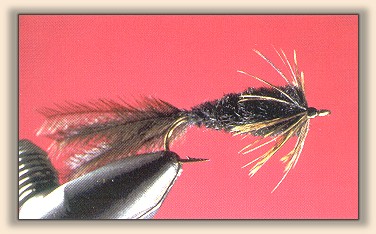The Strymph
By Skip Morris
Harry Murray, author of Fly Fishing for Smallmouth Bass,
created the Strymph. If you are familiar with either the man or the
fly, that should settle the credibility issue for both.
Harry treats the Strymph as a sort of all-purpose, smallmouth-bass
fly. He uses it as both a streamer and a nymph. In his book he lists
all kinds of creatures upon which smallmouths feed and which may be
imitated by Strymphs of various colors, creatures such as damselfly
nymphs, hellgrammites, leeches, tadpoles and scupins - and that's
less than half the list.
The Black Strymph was the first. Harry now ties his Strymph in olive
and cream and suggests that nearly any natural color may be used.
His rule is, the tail and body should be of one color, and the
hackle's color and markings should blend with that.
I couldn't find it said outright in his book, but I assume that
the name "Strymph" is a combination of the words "streamer" and
"nymph" since Harry fishes it as both (and since that conclusion
is so blessed obvious). How it is fished depends, of course,
upon what it's being used to imitate. If you want it to suggest
a drifting stonefly nymph, let it ride freely with the current
along the stream bed; to imitate a minnow, make it swim like one.
The Strymph, in various colors and sizes, suggests so many things
upon which smallmouths feed, that you could make a hobby out of
finding ways to fish it.
Materials List:
Hook: Heavy wire, 2X or 3X long, sizes 8 to 2.
(The hook shown is a Gamakatsu F-36.)
Thread: Three-ought of a color to match the color of
the body.
Weight: Lead wire.
Tail: Ostrich herl of a color to match the color of the body.
Body: Black, olive, or cream rabbit fur.
Hackle: Speckled brown hen saddle.
Tying Instructions:
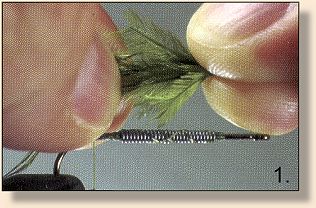
1. Start the thread at mid-shank and spiral it back to
the bend. Wrap a layer of lead wire [or substitute] over
most of the shank, but terminate the wire well short of the hook's
eye and bend. Secure the lead with right thread-turns. Murray
suggested using lead-wire that is about the same diameter as
the hook's wire.
Find a stretch of ostrich herls, on the feather, that are
full and long-fibered. Stroke 15 to 20 herls out to an
angle that roughly evens their tips. Snip the fibers
free at their base; hold the fibers firmly to keep their
tips even. Tear off the very tips of the herl bunch with
your thumbnail.
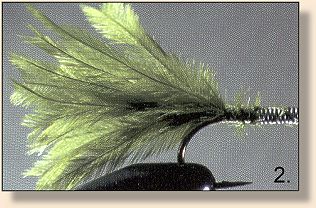
2. Measure and then bind on the herls at the bend, using the pinch.
They should extend from the bend a distance roughly equal to the
length of the hook's shank. Trim the herl's butts where they meet
the lead.
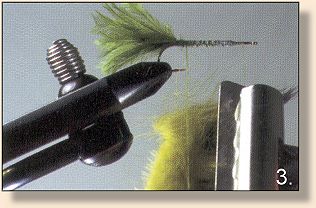
3. Wax the thread and then double it into a loop at least
5 inches (around 13 cm) long. Using the bobbin, wrap the
thread back to secure both ends of the loop. Advance the
thread to just back from the hook's eye. Hook a dubbing
twister into the end of the loop. Snip some rabbit fur from
the hide and put it into the loop - or, first, clamp it in a
bulldog-clip (from an office-supply store) as shown here.
The clip is clamped onto fur that is attached to a strip of
hide, then the hide is cut from the fur. The clip is removed
only after the fur is in the loop.
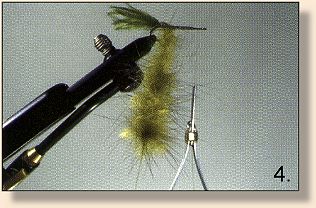
4. Keep constant light tension on the loop. Pinch its sides
together as you tease the fur apart, distribute it along the
loop. The fur fibers should be at roughly a right angle to
the thread. Try to position the fibers so that the thread holds
them at their centers - this may take a few very light pushes or
taps.
Spin the dubbing twister until the fur is tightly locked into the loop.
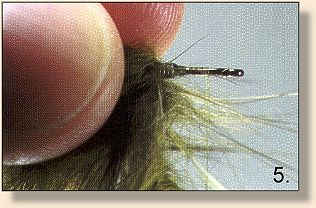
5. Wind the fur-loop up the shank, drawing the fur back
after each turn is added.
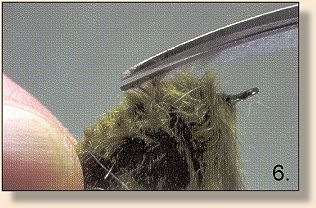
6. Secure the thread loop just back from the eye by binding
it with tight thread-turns. Trim the end of the loop. Whip
finish the thread.
Remove the hook from your vise and trim the body to a taper
as shown. Your can work around the hanging thread or trim it
and restart later, whichever you wish.
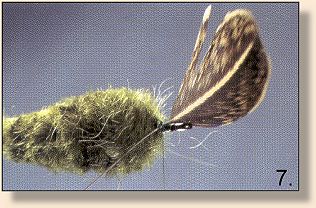
7. Pluck a hen-saddle hackle from the skin. Strip the hackle of
its fuzz along the base of the stem. The longest remaining fibers
shouldn't be much more than half the length of the shank. Bind
the hackle on by its stem, just behind the hook's eye. The body
of the feather should now project forward, off the eve. Wrap the
thread back in close, tight turns along stem and hook's
shank to the front of the body.
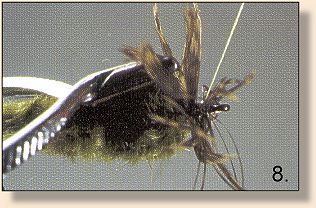
8. Trim off the hackle's stem. Wind the hackle back in 2
consecutive turns. Wind the thread over the tip of the hackle
to secure it. Whisk your fingertip across the hackle fibers to
make them seperate. Spiral the thread forward through the
hackle fibers to the hook's eye.
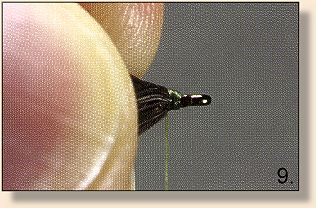
9. Trim out the feather's tip. Stroke back the feather's fibers using
the triangle; then build and complete a thread head.
~ Skip Morris
Credits: The Strymph is one of the many excellent
instructional flies presented in Skip Morris's book,
The Art of Tying the Bass Fly, published by
Frank Amato Publications.
|

